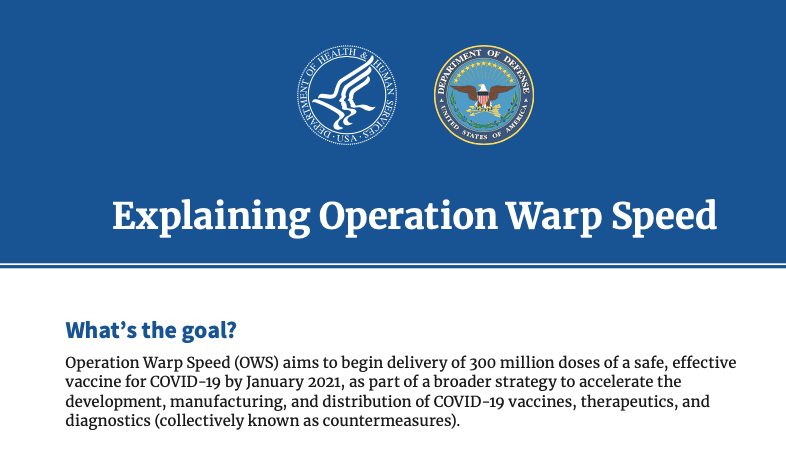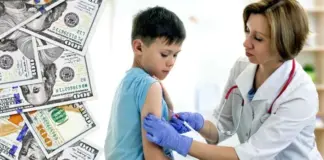What’s the goal?
Operation Warp Speed (OWS) aims to begin delivery of 300 million doses of a safe, effective vaccine for COVID-19 by January 2021, as part of a broader strategy to accelerate the development, manufacturing, and distribution of COVID-19 vaccines, therapeutics, and
diagnostics (collectively known as countermeasures).
How will the goal be accomplished?
By investing in and coordinating countermeasure development, OWS will allow
countermeasures such as a vaccine to be delivered to patients more rapidly while adhering to standards for safety and efficacy.
Who’s working on Operation Warp Speed?
OWS is a partnership among components of the Department of Health and Human Services
(HHS), including the Centers for Disease Control and Prevention (CDC), the Food and Drug
Administration (FDA), the National Institutes of Health (NIH), and the Biomedical Advanced
Research and Development Authority (BARDA), and the Department of Defense (DoD).
OWS engages with private firms and other federal agencies, including the Department of
Agriculture, the Department of Energy, and the Department of Veterans Affairs. It will
coordinate existing HHS-wide efforts, including the NIH’s Accelerating COVID-19 Therapeutic Interventions and Vaccines (ACTIV) partnership, NIH’s Rapid Acceleration of Diagnostics (RADx) initiative, and work by BARDA.
What’s the plan and what’s happened so far?
DEVELOPMENT: To accelerate development while maintaining standards for safety and
efficacy, OWS has been selecting the most promising countermeasure candidates and
providing coordinated government support.
Protocols for the demonstration of safety and efficacy are being aligned, which will allow
these harmonized clinical trials to proceed more quickly, and the protocols for the trials
will be overseen by the federal government (NIH), as opposed to traditional public-private
partnerships, in which pharmaceutical companies decide on their own protocols. Rather than eliminating steps from traditional development timelines, steps will proceed simultaneously, such as starting manufacturing of vaccines and therapeutics at industrial scale well before the demonstration of efficacy and safety as happens normally. This increases the financial risk, but not the product risk.
Select actions to support OWS vaccine and therapeutic development so far include:
•
March 30: HHS announced $456 million in funds for Johnson & Johnson’s (Janssen) candidate vaccine. Phase 1 clinical trials began in Belgium on July 24th and in the U.S on July 27th.
•
April 16: HHS made up to $483 million in support available for Moderna’s candidate
vaccine, which began Phase 1 trials on March 16 and received a fast-track designation
from FDA. This agreement was expanded on July 26 to include an additional $472 million
to support late-stage clinical development, including the expanded Phase 3 study of the
company’s mRNA vaccine, which began on July 27th.
•
May 21: HHS announced up to $1.2 billion in support for AstraZeneca’s candidate vaccine,
developed in conjunction with the University of Oxford. The agreement is to make
available at least 300 million doses of the vaccine for the United States, with the first doses
delivered as early as October 2020 and Phase 3 clinical studies beginning this summer
with approximately 30,000 volunteers in the United States.
•
July 7: HHS announced $450 million in funds to support the large-scale manufacturing of
Regeneron’s COVID-19 investigational anti-viral antibody treatment, REGN-COV2. This
agreement is the first of a number of OWS awards to support potential therapeutics all
the way through to manufacturing. As part of the manufacturing demonstration project,
doses of the medicine will be packaged and ready to ship immediately if clinical trials are
successful and FDA grants EUA or licensure.
•
July 7: HHS announced $1.6 billion in funds to support the large-scale manufacturing of
Novavax’s vaccine candidate. By funding Novavax’s manufacturing effort, the federal
government will own the 100 million doses expected to result from the demonstration project.
•
July 22: HHS announced up to $1.95 billion in funds to Pfizer for the large-scale
manufacturing and nationwide distribution of 100 million doses of their vaccine
candidate. The federal government will own the 100 million doses of vaccine initially
produced as a result of this agreement, and Pfizer will deliver the doses in the United
States if the product successfully receives FDA EUA or licensure, as outlined in FDA
guidance, after completing demonstration of safety and efficacy in a large Phase 3 clinical
trial, which began July 27th.
•
July 31: HHS announced approximately $2 billion in funds to support the advanced
development, including clinical trials and large scale manufacturing, of Sanofi
and GlaxoSmithKline’s (GSK) investigational adjuvanted vaccine. By funding the
manufacturing effort, the federal government will own the approximately 100 million
doses expected to result from the demonstration project. The adjuvanted vaccine
doses could be used in clinical trials or, if the FDA authorizes use, as outlined in agency
guidance, the doses would be distributed as part of a COVID-19 vaccination campaign.
•
August 5: HHS announced approximately $1 billion in funds to support the large-scale
manufacturing and delivery of Johnson & Johnson’s (Janssen) investigational vaccine
candidate. Under the terms of the agreement, the U.S. Government will own the resulting
100 million doses of vaccine, and will have the option to acquire more. The company’s
investigational vaccine relies on Janssen’s recombinant adenovirus technology, AdVac, a
technology used to develop and manufacture Janssen’s Ebola vaccine with BARDA support;
that vaccine received European Commission approval and was used in the Democratic
Republic of the Congo (DRC) and Rwanda during the 2018-2020 Ebola outbreak that began
in the DRC.
•
August 11: HHS announced up to $1.5 billion in funds to support the large-scale manufacturing and delivery of Moderna’s investigational vaccine candidate. Under the terms of the agreement, the U.S. Government will own the resulting 100 million doses of vaccine, and will have the option to acquire more. The vaccine, called mRNA-1273, has been co-developed by Moderna and scientists from the National Institute of Allergy and Infectious Diseases (NIAID), part of the National Institutes of Health. NIAID has continued to support the vaccine’s development including nonclinical studies and clinical trials. Additionally, BARDA has supported phase 2/3 clinical trials, vaccine manufacturing scale up and other development activities for this vaccine. The Phase 3 clinical trial, which began July 27, is the first government-funded Phase 3 clinical trial for a COVID-19 vaccine in the United States.
As announced on May 15, the vaccine development plan is as follows, subject to change as
work proceeds:
•
Fourteen promising candidates have been chosen from the 100+ vaccine candidates
currently in development—some of them already in clinical trials with U.S. government
support.
•
The 14 vaccine candidates are being narrowed down to about seven candidates, representing the most promising candidates from a range of technology options (nucleic acid, viral vector, protein subunit), which will go through further testing in early-stage clinical trials.
•
Large-scale randomized trials for the demonstration of safety and efficacy will proceed
for the most promising candidates.
MANUFACTURING: The federal government is making investments in the necessary
manufacturing capacity at its own risk, giving firms the confidence to invest aggressively
in development which will allow faster distribution of an eventual vaccine. Manufacturing
capacity for selected candidates will be advanced while they are still in development, rather
than scaled up after approval or authorization. Manufacturing capacity developed will be used for whatever vaccine is eventually successful, if possible given the nature of the successful product, regardless of which firms have developed the capacity.
Select actions to support OWS manufacturing efforts so far include:
•
The May 21, April 16, and March 30 HHS agreements with AstraZeneca, Moderna, and
Johnson & Johnson respectively include investments in manufacturing capabilities.
•
June 1: HHS announced a task order with Emergent BioSolutions to advance domestic
manufacturing capabilities and capacity for a potential COVID-19 vaccine as well as
therapeutics, worth approximately $628 million, using Emergent’s BARDA-supported
Center for Innovation in Advanced Department and Manufacturing.
•
July 27: HHS announced a task order with Texas A&M University and FUJIFILM to advance
domestic manufacturing capabilities and capacity for a potential COVID-19 vaccine, worth
approximately $265 million, using another BARDA-supported CIADM.
•
August 4: Grand River Aseptic Manufacturing Inc., (GRAM) Grand Rapids, Michigan,
was awarded a $160 million firm-fixed-price contract for domestic aseptic fill and
finish manufacturing capacity for critical vaccines and therapeutics in response to the
COVID-19 pandemic.
DISTRIBUTION: Before the countermeasures are approved or authorized, the program will
build the necessary plans and infrastructure for distribution.
HHS plans for a tiered approach to vaccine and therapeutic distribution, which will build
on allocation methodology developed as part of pandemic flu planning and be adjusted
based on experience from the COVID-19 response so far, data on the virus and its impact
on populations and the performance of a given countermeasure, and the needs of the
essential workforce. OWS will expand domestic manufacturing and supplies of specialized
materials and resources, such as glass vials, that can be necessary for distribution. DoD’s
involvement will enable faster distribution and administration than would have otherwise
been possible.
Select actions to support OWS distribution efforts include:
•
May 12: DoD and HHS announced a $138 million contract with ApiJect for more than 100
million prefilled syringes for distribution across the United States by year-end 2020, as
well as the development of manufacturing capacity for the ultimate production goal of
over 500 million prefilled syringes in 2021.
•
June 9: HHS and DoD announced a joint effort to increase domestic manufacturing
capacity for vials that may be needed for vaccines and treatments::
•
June 11: HHS announced $204 million in funds to Corning to expand the domestic
manufacturing capacity to produce approximately 164 million Valor Glass vials per
year if needed. Valor Glass provides chemical durability to minimize particulate
contamination. The specialized glass allows for rapid filling and capping methods
that can increase manufacturing throughput by as much as 50 percent compared with
conventional filling lines, which in turn can reduce the overall manufacturing time for
vaccines and therapies.
•
June 11: HHS announced $143 million to SiO2 Materials Science to ramp up capacity to
produce the company’s glass-coated plastic container, which can be used for drugs and
vaccines. The new lines provide the capacity to produce an additional 120 million vials per
year if needed.
Who’s leading Operation Warp Speed?
HHS Secretary Alex Azar and Defense Secretary Mark Esper oversee OWS, with Dr. Moncef
Slaoui designated as chief advisor and General Gustave F. Perna confirmed as the chief
operating officer. To allow these OWS leaders to focus on operational work, in the near
future the program will be announcing separate points of contact, with deep expertise and
involvement in the program, for communication with Congress and the public.
What are you doing to make these products
affordable for Americans?
The Administration is committed to providing free or low-cost COVID-19 countermeasures to the American people as fast as possible. Any vaccine or therapeutic doses purchased with US taxpayer dollars will be given to the American people at no cost.
How is Operation Warp Speed being funded?
Congress has directed almost $10 billion to this effort through supplemental funding,
including the CARES Act. Congress has also appropriated other flexible funding. The almost
$10 billion specifically directed includes more than $6.5 billion designated for countermeasure development through BARDA and $3 billion for NIH research.
Disclaimer: We at Prepare for Change (PFC) bring you information that is not offered by the mainstream news, and therefore may seem controversial. The opinions, views, statements, and/or information we present are not necessarily promoted, endorsed, espoused, or agreed to by Prepare for Change, its leadership Council, members, those who work with PFC, or those who read its content. However, they are hopefully provocative. Please use discernment! Use logical thinking, your own intuition and your own connection with Source, Spirit and Natural Laws to help you determine what is true and what is not. By sharing information and seeding dialogue, it is our goal to raise consciousness and awareness of higher truths to free us from enslavement of the matrix in this material realm.
 EN
EN FR
FR


























